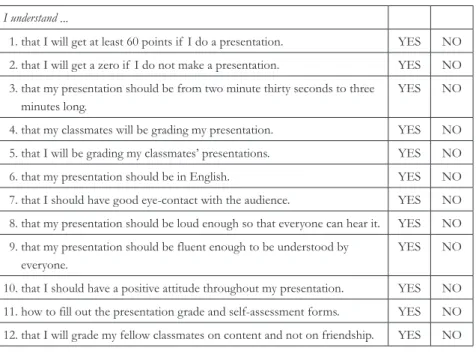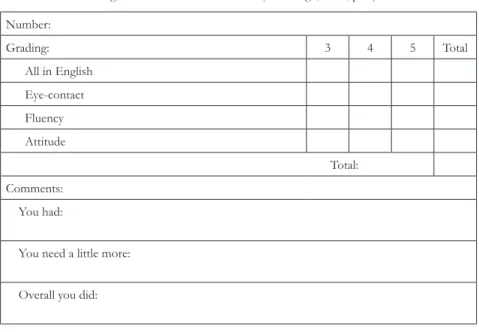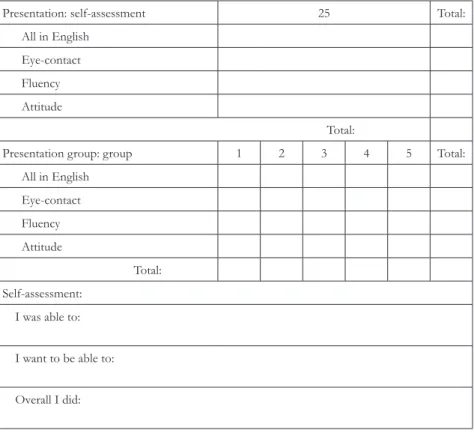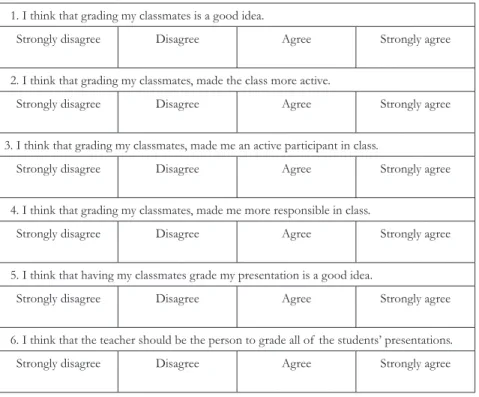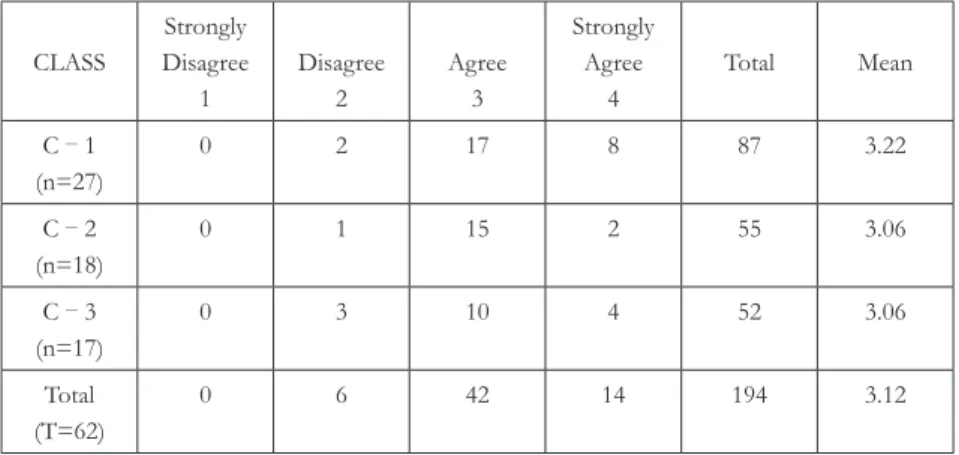Abstract
The purpose of this study is to see how EFL students assess their own learning and motivation. A questionnaire was given to 62 non-English majors, 27 first-year and 35 second-first-year students from two different universities in Japan, in order to learn how the students regarded their classroom participation and motivation. The results of two research questions are evaluated: 1. Do peer and self-assessment of speeches make the students feel more responsible for their own learning? 2. Do peer and self-assessment of speeches have an effect on students’ motivation? The results clearly show that peer and self-assessments do have a positive effect on learning and motivation. The benefits of this study could be utilized to foster future student self- and peer-assessments in EFL classrooms. The initial reason for conducting this research was to investigate if students would feel more motivated if their peers were to grade their oral presentations. In a typical oral presentation classroom, there is one presenter and the remainder of the class serves as an audience. Depending on the instructor, sometimes the listening audience would be required to critique the presentation, reflect on what they can learn from the presentation, or indicate how they can improve their own presentations. Masmaliyeva (2014) stated that instructors are often frustrated with maintaining the class attention during oral presentations: students engage in silent but audible conversations, others sometimes mock the presenter, because most of the time the students may not be responsible for doing much but to listen to the presentations. Many educators believe that “students need to be given more responsibility for their own learning” (van’t Hooft, Brown-Martin, & Swam, 2008: 39).
Presentation Classes through Use of Peer- and Self-assessments
In this study, the students’ perceptions regarding their classroom participation and motivation during oral presentations is investigated. For the purpose of this study two research questions were developed: 1. Do peer- and self-assessment of speeches make the students feel more responsible for their own learning? 2. Do peer and self-assessment of speeches have an effect on students’ motivation?
Literature Review
Motivation has been a major issue when it comes to second language learning. Brown (2000) divides motivation into extrinsic motivation and intrinsic motivation. Extrinsic motivation “comes from outside factors” (Harmer, 2001: 51) in “anticipating a reward” (Brown, 2000: 164). Extrinsic motivation is short-term reinforcement. Being intrinsically motivated as defined by Edward Deci in Brown (2000) means “there is no apparent reward except the activity itself” (p. 164) which “comes from within the individual” (Harmer, 2001: 51).
In this study a focus is on self-assessment’s effect on motivation. “Student self-assessment can promote intrinsic motivation” (McMillan, and Hearn, 2008: 40). Teachers should encourage self-evaluation because self-assessment makes the students active participants in their education (Sloan, 1996) and “student self-assessment stands alone in its promise of improved student motivation and engagement, and learning” (McMillan, and Hearn, 2008: 40).
The Present Study
A questionnaire was given to 62 non-English majors; 27 first-year and 35 second-year students from two different universities in Japan. The questionnaire was given to the students after the class had completed their oral presentation assignment. In total the questionnaire had 12 questions. Nine questions required the students to answer using a Likert scale: 1=strongly disagree, 2=disagree, 3=agree, and 4=strongly agree; two questions required a no or yes response, and for the last question the students were given the opportunity to write down any comments or concerns that they may have had in class or about the presentations. The questionnaire was anonymous. Table 1 is the results of the questionnaire with the mean score of each class and the mean score of the total.
Procedure
In the semester the students are expected to prepare and make two different oral presentations of three minute each. The students are also required to fill-in the contents of a blank scrap book. The scrap book is used to help illustrate and to be used as a visual aid for the students’ presentation. The contents of the scrap book were based on topics from the textbook that is used in class. However, the students have the liberty to interpret the topics anyway they wanted to. For example, if the topic was food, the students could talk about what they like to eat, what they like to cook, where they like to go to eat, and they would have to use pictures from their scrap book. The students prepared their scrap books at home and it was graded as homework.
The students were told at the beginning of the semester that they would be graded and would be grading their classmates’ presentations. They are reminded
Figure 1: Presentation Assessment Comprehension Checklist (from Higa, 2015, p.43)
I understand ...
1. that I will get at least 60 points if I do a presentation. YES NO 2. that I will get a zero if I do not make a presentation. YES NO 3. that my presentation should be from two minute thirty seconds to three
minutes long.
YES NO 4. that my classmates will be grading my presentation. YES NO 5. that I will be grading my classmates’ presentations. YES NO 6. that my presentation should be in English. YES NO 7. that I should have good eye-contact with the audience. YES NO 8. that my presentation should be loud enough so that everyone can hear it. YES NO 9. that my presentation should be fluent enough to be understood by
everyone.
YES NO 10. that I should have a positive attitude throughout my presentation. YES NO 11. how to fill out the presentation grade and self-assessment forms. YES NO 12. that I will grade my fellow classmates on content and not on friendship. YES NO
of this two weeks prior to the presentations with a checklist (see Figure 1). The checklist is to check their understanding of what they are to do, that their presentations will be graded by the peer-assessment group, and that they will also be a part of a peer-assessment group.
The peer-assessment group consist of five students. They all volunteer to be in the group; the presentation does not start until there are five students in the peer-assessment group. After the presentation a new set of five students rotate in for the next presentation. In the peer-assessment group, each of the five members could award from 12 to 20 points to the presenter. If each of the five members in the peer-assessment group gave the lowest score of 12 to the presenter, the presenter could receive the score of 60, which is a passing score.
One of the major concerns of the students was that they did not feel comfortable about grading each other. Therefore, the students were all made aware that if they did the presentation the lowest score they could get from the peer-assessment group was 60 points. The students were also made aware that their final presentation score would be partly based on the total peer-assessment
Figure 2: Peer-assessment Form (from Higa, 2015, p.44) Number: Grading: 3 4 5 Total All in English Eye-contact Fluency Attitude Total: Comments: You had:
You need a little more: Overall you did:
group evaluation score.
On the day of the presentation, the five-member peer-assessment group assembles before each presentation. While the student presents, each of the five peer-assessment group members fill out the peer-assessment sheet (see Figure 2). Awarding three to five points for each of the four presentation skills (All in English, Eye-contact, Fluency, and Attitude), they total up their final score, and then give some feedback for the presentation (You had:, You need a little more:, Over all you did:). The peer-assessment form is to be given to the presenter when it is completed.
After the presentation, the presenter is required to fill out a self-assessment
Figure 3: Self-assessment Form (from Higa, 2015, p.44)
Presentation: self-assessment 25 Total: All in English
Eye-contact Fluency Attitude
Total: Presentation group: group 1 2 3 4 5 Total: All in English Eye-contact Fluency Attitude Total: Self-assessment:
I was able to: I want to be able to: Overall I did:
form, giving him/herself a numerical self-assessment grade. He/she can award him/herself up to 25 points for each of the four presentation skills (All in English, Eye-contact, Fluency, and Attitude) then self-assess themselves (I was able to:, I want to be able to:, over all I did:). He/she then records the peer-assessments scores as he/she receives them from the five-member peer-assessment group and writes a short self-evaluation comment about his/her presentation (see Figure 3 below).
Instrument
The questions on the questionnaire (Figure 4) were designed by the instructor and colleague based on the research questions.
Figure 4: Student’s Questionnaire 1. I think that grading my classmates is a good idea.
Strongly disagree Disagree Agree Strongly agree 2. I think that grading my classmates, made the class more active.
Strongly disagree Disagree Agree Strongly agree 3. I think that grading my classmates, made me an active participant in class.
Strongly disagree Disagree Agree Strongly agree 4. I think that grading my classmates, made me more responsible in class.
Strongly disagree Disagree Agree Strongly agree 5. I think that having my classmates grade my presentation is a good idea.
Strongly disagree Disagree Agree Strongly agree 6. I think that the teacher should be the person to grade all of the students’ presentations. Strongly disagree Disagree Agree Strongly agree
Data Collection
The questionnaire was given to the students the week after all of their oral presentations were completed. At the beginning of class, the questions were read out loud by the instructor and any questions or requests for clarifications were answered by the instructor. The students were instructed not to write their names on the questionnaires. The questionnaire was collected and tabulated.
Data Analysis
On the questionnaire, each of the answers were given a numerical value: strongly disagree=1, disagree=2, agree=3, strongly agree=4, no=2 and yes=4. The results were tabulated and the average scores for each class was calculated, Then the mean, range, and standard deviation for each question was calculated.
Results
Question 1: I think that grading my classmates is a good idea.
The mean for each class was 3.22, 3.06, and 3.06 respectively, with the total
7. I think the self-assessment process made me think about my own learning.
Strongly disagree Disagree Agree Strongly agree 8. I think that self-assessment motivated me to try harder.
Strongly disagree Disagree Agree Strongly agree 9. I think self-assessment motivated me to be more responsible for my own language
learning.
Strongly disagree Disagree Agree Strongly agree 10. Did I grade myself lower than the teacher? No Yes Why?
11. I like being in the peer-assessment group. No Yes Why?
mean score of 3.13.
Question 2: I think that grading my classmates, made this class more active. The mean for each class was 2.89, 3.00, and 2.53 respectively, with the total mean score of 2.82.
Question 3: I think that grading my classmates, made me an active participant in class
The mean for each class was 3.11, 3.00, and 2.76 respectively, with the total mean score of 2.98.
Question 4: I think that grading my classmates, made me more responsible in class. The mean for each class was 2.89, 3.00, and 2.53 respectively, with the total mean score of 2.82.
Question 5: I think having my classmates grade my presentation is a good idea. The mean for each class was 3.19, 3.17, and 2.72 respectively, with the total mean score of 3.06.
Question 6: I think that the teacher should be the person to grade all of the students’ presentations.
The mean for each class was 2.41, 2.33, and 2.65 respectively, with the total mean score of 2.45.
Question 7: I think the self-assessment process made me think about my own learning.
The mean for each class was 2.41, 2.33, and 2.65 respectively, with the total mean score of 2.45.
Question 8: I think that self-assessment motivated me to try harder.
The mean for each class was 2.85, 3.06, and 2.76 respectively, with the total mean score of 2.89.
Question 9: I think self-assessment motivated me to be more responsible for my own language learning.
The mean for each class was 2.85, 2.88, and 2.88 respectively, with the total mean score of 2.87.
Question 10: Did I grade myself lower than the teacher? No = 2 Yes = 4 Why? The mean for each class was 3.52, 2.82, and 3.17 respectively, with the total mean score of 3.23.
Question 11: I liked being in the peer-assessment group. No = 2 Yes = 4 Why? The mean for each class was 3.76, 3.88, and 3.88 respectively, with the total
mean score of 3.83.
Question 12: Free comment in English Comments are posted in the Appendix.
Table 1: Results of Questionnaire 1. I think that grading my classmates is a good idea.
CLASS Strongly Disagree 1 Disagree 2 Agree 3 Strongly Agree 4 Total Mean C ― 1 (n=27) 0 2 17 8 87 3.22 C ― 2 (n=18) 0 1 15 2 55 3.06 C ― 3 (n=17) 0 3 10 4 52 3.06 Total (T=62) 0 6 42 14 194 3.12
2. I think that grading my classmates, made this class more active. CLASS Strongly Disagree 1 Disagree 2 Agree 3 Strongly Agree 4 Total Mean C ― 1 (n=27) 0 6 18 3 78 2.89 C ― 2 (n=18) 0 2 14 2 54 3.00 C ― 3 (n=17) 0 9 7 1 43 2.53 Total (T=62) 0 17 39 6 175 2.82
3. I think that grading my classmates, made me an active participant in class. CLASS Strongly Disagree 1 Disagree 2 Agree 3 Strongly Agree 4 Total Mean C ― 1 (n=27) 0 1 22 4 84 3.11 C ― 2 (n=18) 0 2 14 2 54 3.00 C ― 3 (n=17) 0 4 13 0 47 2.76 Total (T=62) 0 7 49 6 185 2.98
4. I think that grading my classmates, made me more responsible in class. CLASS Strongly Disagree 1 Disagree 2 Agree 3 Strongly Agree 4 Total Mean C ― 1 (n=27) 1 5 18 3 78 2.89 C ― 2 (n=18) 0 4 13 1 54 3.00 C ― 3 (n=17) 0 6 11 0 43 2.53 Total (T=62) 1 15 42 4 175 2.82
5. I think having my classmates grade my presentation is a good idea. CLASS Strongly Disagree 1 Disagree 2 Agree 3 Strongly Agree 4 Total Mean C ― 1 (n=27) 0 4 14 9 86 3.19 C ― 2 (n=18) 0 2 11 5 57 3.17 C ― 3 (n=17) 1 3 12 1 47 2.76 Total (T=62) 1 9 37 15 190 3.06
6. I think that the teacher should be the person to grade all of the students’ presentations. CLASS Strongly Disagree 1 Disagree 2 Agree 3 Strongly Agree 4 Total Mean C ― 1 (n=27) 1 15 10 1 65 2.41 C ― 2 (n=18) 3 7 7 1 42 2.33 C ― 3 (n=17) 0 7 9 1 45 2.65 Total (T=62) 4 29 26 3 152 2.45
7. I think the self-assessment process made me think about my own learning. CLASS Strongly Disagree 1 Disagree 2 Agree 3 Strongly Agree 4 Total Mean C ― 1 (n=27) 1 2 19 5 82 3.04 C ― 2 (n=18) 0 3 13 2 53 2.94 C ― 3 (n=17) 1 5 11 0 44 2.59 Total (T=62) 2 10 43 7 179 2.89
8. I think that self-assessment motivated me to try harder. CLASS No mark 0 Strongly Disagree 1 Disagree 2 Agree 3 Strongly Agree 4 Total Mean C ― 1 (n=27) 0 1 7 14 5 77 2.85 C ― 2 (n=18) X 0 2 12 3 52 2.88 C ― 3 (n=17) 0 0 6 9 2 47 2.76 Total (T=62) 1 1 15 35 10 176 2.83
9. I think self-assessment motivated me to be more responsible for my own language learning. CLASS No mark 0 Strongly Disagree 1 Disagree 2 Agree 3 Strongly Agree 4 Total Mean C ― 1 (n=27) 0 1 3 22 1 77 2.85 C ― 2 (n=18) X 0 3 13 1 49 2.72 C ― 3 (n=17) 0 0 4 12 1 49 2.88 Total (T=62) 1 1 10 47 3 175 2.82
10. Did I grade myself lower than the teacher? No=2 Yes=4 Why? CLASS No mark 0 Same 0 No 2 Yes 4 Total Mean C ― 1 (n=27) X 0 6 20 94 3.48 C ― 2 (n=18) 0 XX 10 7 48 2.66 C ― 3 (n=17) 0 0 7 10 54 3.17 Total (T=62) 0 0 23 37 196 3.16
Discussion
Question 1: I think that grading my classmates is a good idea.
The results for question 1 show that a majority of the students (90% ) thought that grading their classmates was a good idea. Only six out of 62 students disagreed.
Question 2: I think that grading my classmates made this class more active.
The results for question 2 show that 72% of the students thought that grading their classmates made the class more active. However, more than half of the students in C-3, 9 out of 17, did not think that grading their classmates made the class more active.
Question 3: I think that grading my classmates made me an active participant in class.
The results for question 3 show that 89% of the students thought that grading their classmates made them an active participant in class. Only 7 students thought that grading their classmates did not make them an active participant in class.
Question 4: I think that grading my classmates, made me more responsible in class.
The results for question 4 show that 74% of the class thought that grading their classmates made them feel more responsible in class.
Question 5: I think having my classmates grade my presentation is a good idea.
The results for question 5 show that 83% thought that having their classmates grade them was a good idea. This point could be best illustrated by one student who wrote, “because only teacher’s assessment is not fair”.
11. I liked being in the peer-assessment group. No=2 Yes=4 Why? CLASS No mark 0 No 2 Yes 4 Total Mean C ― 1 (n=27) X 3 23 92 3.40 C ― 2 (n=18) X 1 16 64 3.55 C ― 3 (n=17) 0 1 16 64 3.88 Total (T=62) 2 5 55 220 3.54
Question 6: I think that the teacher should be the person to grade all of the students’ presentations.
The results for question 6 show that 46% think that the teacher should be the person to grade all of the students’ presentation, whereas the other 53% think that the teacher should not. The results do not seem to be consistent with question 1 and question 5. The results for question 1 show that 90% thought that grading their classmates was a good idea and the results for question 5 shows that 83% of the students thought that having classmates grade their presentation was a good idea. It could be assumed that the students may have misunderstood this question. This question should be investigated further.
Question 7: I think the self-assessment process made me think about my own learning.
The results for question 7 show that 80% of the students thought the self-assessment process made the students think about their own learning.
Question 8: I think that self-assessment motivated me to try harder.
The results for question 8 show that 72% of the students thought that self-assessment motivated them to try harder. For this question, one student did not answer.
Question 9: I think self-assessment motivated me to be more responsible for my own language learning.
The results for question 9 show that 81% of the students felt that self-assessment motivated them to be more responsible for their own learning. Question 9 also had a no mark where one student did not answer.
Question 10: Did I grade myself lower than the teacher? No=2 Yes=4 Why?
The results for question 10 show that 59% of the students awarded themselves a grade lower than the teacher’s grade. Question 10 also had a no mark. In this case, one student did not answer this question and another student answered “same,” which has no category.
Question 11: I liked being in the peer-assessment group. No=2 Yes=4 Why?
The results for question 11 were overwhelmingly positive: 88% of the total enjoyed being in the peer-assessment groups. Out of 62 questionnaires, 23 students wrote a comment to this question and all of them answered, yes, and wrote various comments. One student stated that “because my classmates gave me feedback that I can understand”. There were no negative comments. Question 11 had two no mark in two different classes. In this case, two students
did not answer this question.
Question 12: Free comment in English
Students’ responses are listed in the Appendix.
Looking at the results, the majority of the students thought that grading each others’ speeches and having their speeches graded by peers was a good idea. The majority also thought that grading each other made them more active and responsible in class. For the majority of the class, the self-assessment process made them think about their learning, motivated them to be responsible for their own learning, and had them try harder. To answer the research questions:
Research Question 1. Do peer and self-assessment of speeches make the student feel more responsible for their own learning? From the results of this study, the majority of the students felt that the peer and self-assessments made them feel more responsible for their own learning. One student expressed satisfaction by writing “[I can]get a sense of responsibility.” Another student wrote, “because I can have responsibility for my presentation in the class.”
Research Question 2. Do peer and self-assessment of speeches have an effect on students’ motivation? The results of the questionnaire show that the majority of the students thought that self-assessment had an effect on their motivation. Students’ comments like, “I think I can do better than that speech,” “I can do better with more practice,” “I want more practice time,” and “I have to study more” show that the students are trying to improve themselves.
Conclusion
This study shows that peer and self-assessments do have a positive effect on learning and motivation. Peer-assessment focuses the attention away from the teacher and places it back on the students. The students ultimately become responsible for their own learning, classroom participation, and motivation because they take it upon themselves to grade their peers. Self-assessment focuses on the students. They learn what they can do, what they need to do, and what they do not know. The benefits of this study could be utilized to foster future students’ peer-assessments in EFL classrooms.
References
Brown, H.D. (2000). Principles of language learning and teaching (4th ed.). Englewood Cliffs NJ:
Prentice-Hall.
Harmer, J. (2001). The practice of English language teaching (3rd ed.). Harlow, England: Pearson
Education Limited.
Higa, J. (2015). Peer and self-assessment in oral presentation. Mask and Gavel 4 (1), 40―48. Masmaliyeva, L. (2014). Using affective effectively: Oral presentation in EFL classroom.
Journal of Language and Literature Education, 10, 145―154.
McMillan, J. H., and Hearn, J. (2008). Student self-assessment: the key to stronger student motivation and higher achievement. Educational Horizons, Fall.
Sloan, M. (1996). I love this piece because ... strategies to help kids evaluate their own work.
Instructor, 7 (105), 30―32.
van’t Hooft, M., Brown-Martin, G., & Swam, K. (2008) Anywhere, anytime learning using highly mobile devices. In L. Tomei (Ed.) Encyclopedia of information technology curriculum
integration Volume I A-Interactive Videoconferencing Retrived from http://www.rcet.org/
Appendix
The written comments by the students for question 10.
Question 10: Did I grade myself lower than the teacher? No Yes Why?
These are the positive answers and reasons: 1. Yes: because my presentation was so bad 2. Yes: I have to study more
3. Yes: I graded too hard 4. Yes: The teacher is kind
5. Yes: I think I can do better than that speech 6. Yes: I don’t have confidence
7. Yes: I’m not good at English. But I fun this class 8. Yes: I can’t speak English but I’m fun
9. Yes: Same 10. Yes: No confidence
11. Yes: Don’t know the average, could not compare 12. Yes: I think it is lacking in an exercise
Here are the negative responses and reasons: 1. No: I can do better with more practice 2. No: I think my presentation is bad
3. No: Because I think I have an unskilled presentation 4. No: Because I couldn’t do eye-contact
5. No: as expected 6. No: Because AA 7. No: Because I had AA 8. No: I haven’t felt so
9. No: Because I thought to that I was able to make eye-contact The written comments for question 11.
Question 11: I liked being in the peer-assessment group. No Yes Why?
These are the positive answers and reasons: 1. Yes: I didn’t nervous
2. Yes: I can enjoy speaking my speech 3. Yes: I don’t think anything. It’s OK
4. Yes: I listening to presentation of my classmates is fun 5. Yes: Because I enjoyed
6. Yes: good stimulate, I enjoy very much group 7. Yes: we can enjoy
8. Yes: there is a sense of tension 9. Yes: get a sense of responsibility
10. Yes: because my classmates gave me feedback that I can understand 11. Yes: I don’t get as nervous in front of my friends
12. Yes: because my friends are kind
13. Yes: Because it is all out to look at oneself objectively 14. Yes: I can do better if my classmates grade me 15. Yes: I know other people of comment 16. Yes: I like listening presentation 17. Yes: Because I could get advices 18. Yes: don’t get as nervous 19. Yes: Because I feel exciting
20. Yes: I’m glad to cooperation with my friends
21. Yes: Because I can have responsibility for my presentation
22. Yes: communicate with many people and how do they think about my speech 23. Yes: because only teacher’s assessment is not fair
There were no negative comments. Written comment for question 12.
Question 12. Free comment in English
1. I will fight this season 2. I like this class
3. I can’t understand English 4. I want more practice time
